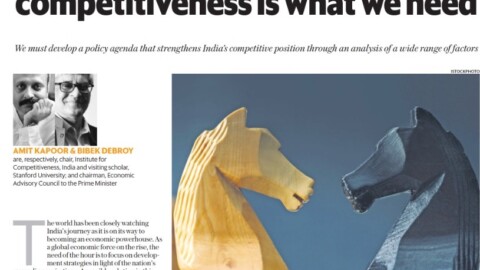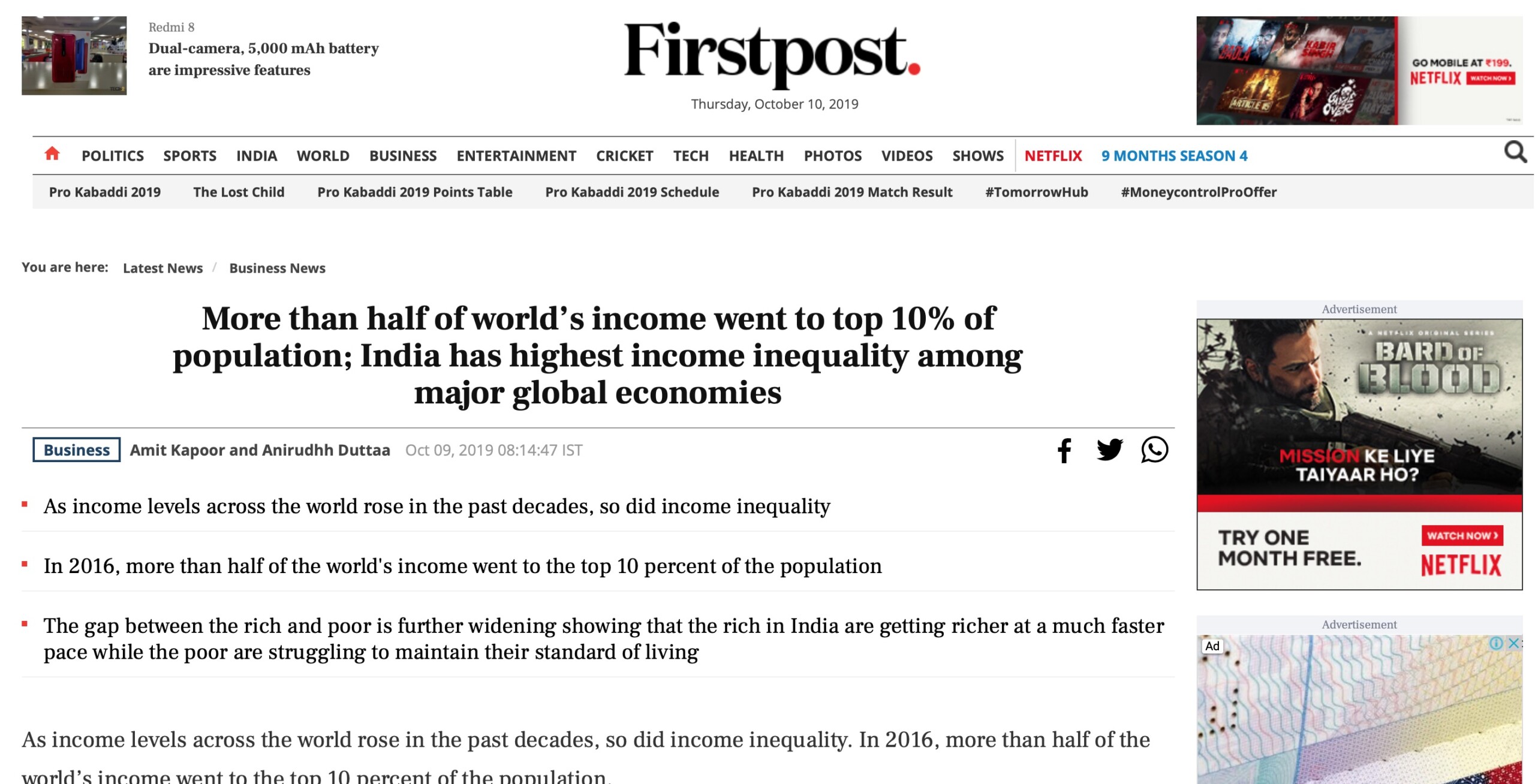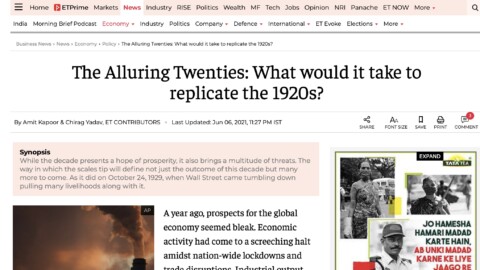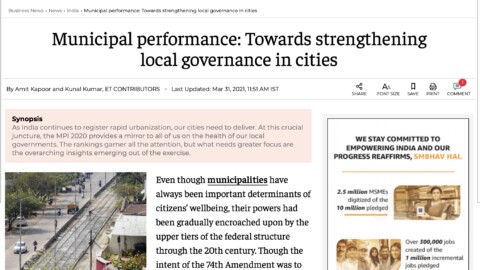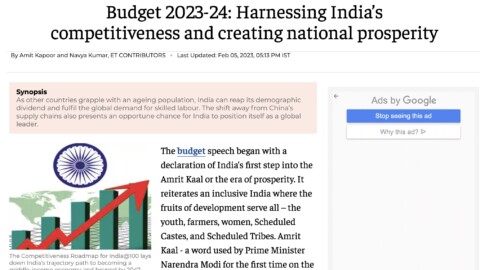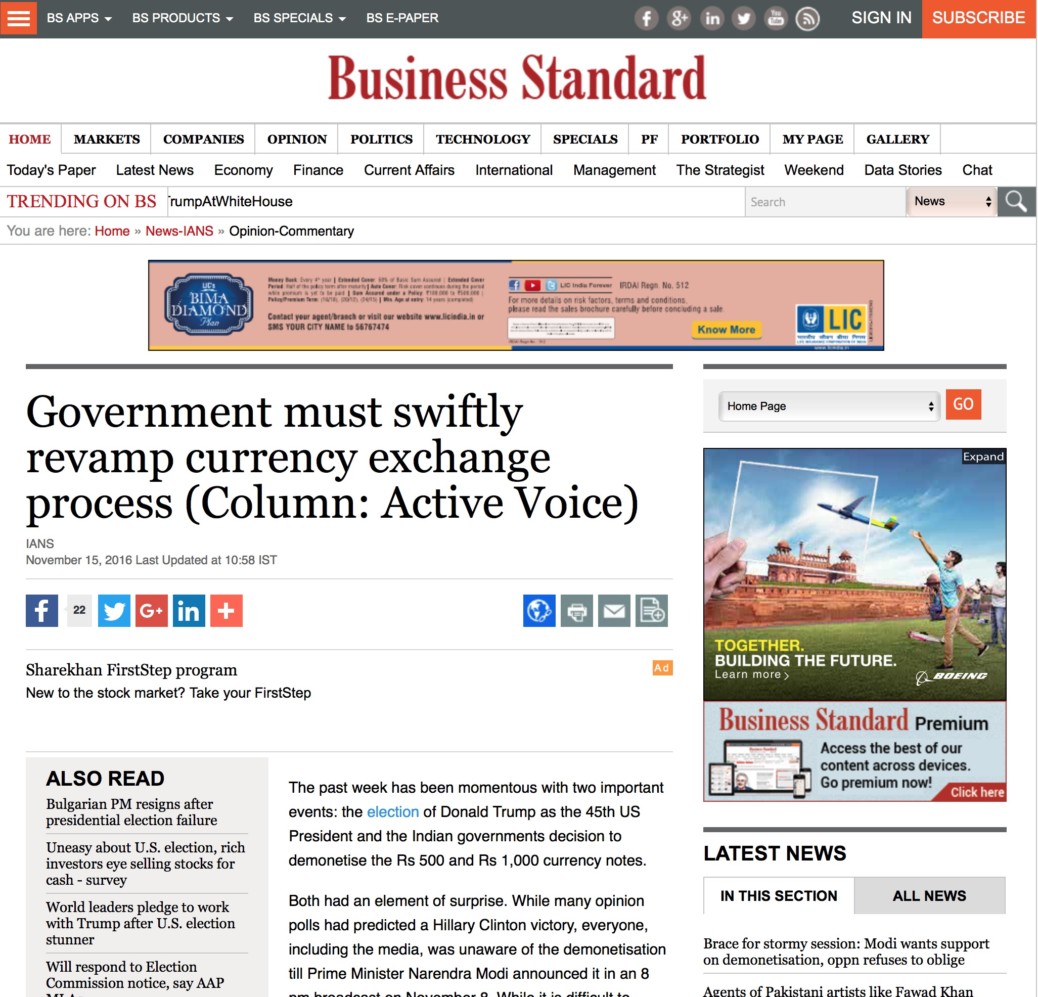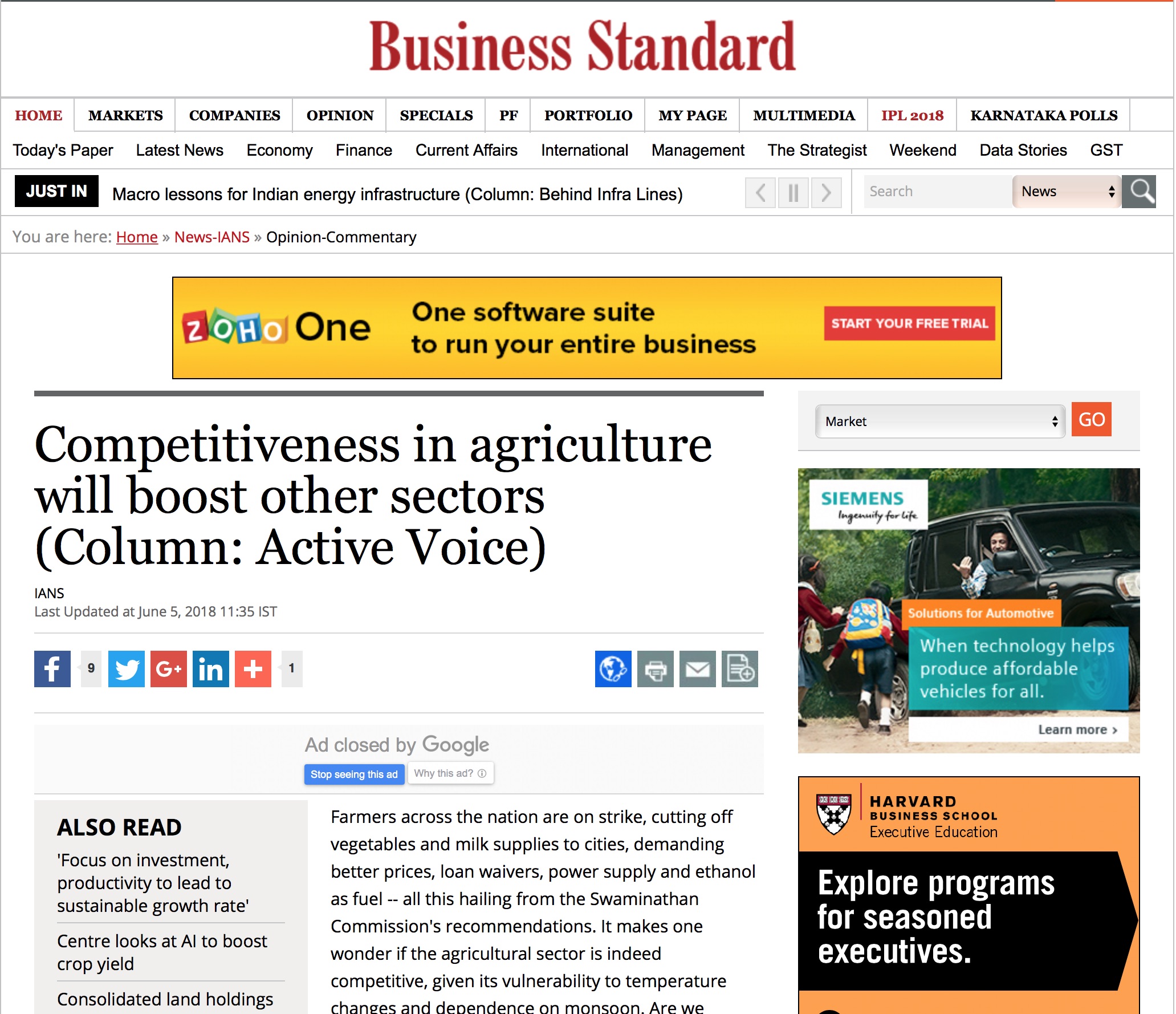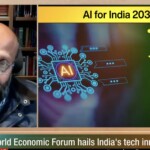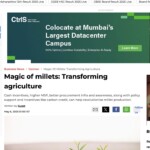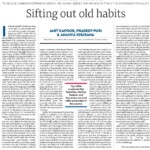The Strategy Delhi need to resolve its water crises
Amit Kapoor and Pradeep Puri
If there is one defining feature of municipal services in large parts of India, it is chronic under funding and under investment. According to the RBI, municipal expenditure is less than 1% of GDP. Compare this with Brazil and South Africa where the corresponding number is 6% and 7.3% of GDP, respectively. As the American slang goes ‘you get what you pay for’.
The traditional argument that we are a poor nation with limited finances does not align with contemporary facts. The Delhi municipal region has a population of over 33 million with a GDP of 133.8 billion in 2023-24 and a per capita income of USD 5579.29. Of course, there is a large proportion of the population employed in the domestic household sector with incomes below the median, but that does not necessarily impact the average household’s capacity to pay.
Delhi’s GDP and per capita income are appreciably higher than some neighbouring countries, including Sri Lanka, which has a GDP of USD 74.59 Billion and a per capita income of around USD 3,330. Despite severe challenges, Sri Lanka’s solid waste management is on a superior footing than many large Indian urban centres.
The GRAP measures commonly introduced every winter in Delhi represent a knee-jerk reaction. GRAP is a calibrated shut down of economic activity. It can be argued that an over emphasis on vehicular pollution, particularly regarding certain categories of BS vehicles is puzzling, apart from the rent seeking it induces, given the fact that between 2021-22 and 22-23 nearly 5.5 million vehicles were deregistered in Delhi, on account of court orders against a registered inventory of almost 12 million vehicles. While there is no direct correlation between the number of registered vehicles and number of vehicles actively plying, a 50% reduction is significant, unless the age profile of the deregistered vehicles suggests, otherwise. Yet there appears to be no consistent decline in the Air Quality Index (AQI), for comparable winter months between 2021 to 2024.
GRAP is an emergency response when air quality falls below certain threshold levels. Its scope does not extend to pre-emptive, sustainable long-term measures. Its ambit does not appear to cover the dozen or so thermal power stations within a 300 km radius of Delhi, which, as per available reports are still in the process of installing the requisite desulfurization processes to clean flue gas emissions.
The GRAP guidelines also barely acknowledge other, more potent, and perennial sources of toxic air pollution, namely solid waste. In April 2022, there was a super emitter event at the Gazipur landfill site, in Delhi, captured by satellite data which showed that methane emissions from the landfill reached 438 metric tons per hour, which is equivalent to 68 million cars plying at the same time, roughly ten times the 7 million or so, total registered vehicles, in Delhi, in March,2023.
Globally, there are two broadly accepted strategies for solid waste management, namely, landfills and various categories of waste processing plants. Given the scarcity of land, new landfills are no longer a viable solution. Waste-to-energy plants that incinerate solid waste to generate power are widely accepted for meeting stringent OECD emission norms. This technology has been used in Japan since the 1960s and is the sole method in Singapore, where of course extensive waste segregation enhances processing efficiency.
While the technology is proven, it’s important to acknowledge the challenges with the current WTE plants in Delhi. Concerns about their track record—particularly issues related to emission standards and efficiency are valid. However, these problems can be partly attributed to gaps in maintenance and financing models, which have left the plants struggling to meet their full potential.
WTE plants can help manage a portion of the waste, their efficiency and environmental impact remain concerns. In addition, addressing waste reduction and recycling rather than relying solely on incineration—would offer a more sustainable approach. The focus should also be on improving waste segregation, ensuring that waste-to-energy technologies are both effective and environmentally sound, and preventing further over-reliance on landfills that continue to harm the environment and public health.
In Delhi, the average daily generation of solid waste is approximately 11000 metric tons per day which is likely to grow significantly as the per capita generation increases from 0.6 kg per head per day to levels in excess of 1.5kg per head. The OECD and developed world generate 3.5kg and higher per capita.
Currently, the three waste to energy plants in Delhi account for 60% of Solid Waste processing, while approximately 3800 metric tons or 40%, is unprocessed and are dumped at three landfill ie Bhalswa, Gazipur and Okhla. These three landfills exceeded their design capacity in 2008 and any further dumping of solid waste at these sites contributes to ground water contamination and poses serious health hazards, for the community in general.
The provision of municipal services and, particularly solid waste management, is hugely capital intensive. The prevailing municipal financing mechanisms are grossly inadequate. In 2023 – 2024, property tax collection by the Municipal Corporation of Delhi (MCD), a major revenue source, was Rs 2317 crores. This roughly corresponds to a tax-to-GDP ratio lower than 1.5 percent. While there is no precise benchmark, it is estimated that if the property tax in Delhi was equivalent to even one percent of the capital value, property tax collections in Delhi would be upwards of Rs 20,000 crore per annum.
It is unlikely, given the complexities involved, that property taxes will be revised meaningfully, or the larger elephant of municipal finances can be addressed in any significant sense, unless we are willing to endorse broad ranging reforms to GST to include urban bodies in the pool for GST allocation This far-reaching idea was recently re-emphasized by Dr. Vijay Kelkar, the principal architect of the GST regime.
In the absence of an overhaul of municipal finances, the tariff route to solid waste management does offer interesting possibilities. In most states, there is an Electricity Regulatory Commission (REC), that sets the power tariff. In Delhi, the DERC approved a tariff for waste-to-energy plants in 2015, at a little below Rs 8 per kWh. As a regulatory body, the commission is primarily, if not exclusively, tasked with determining the cost of power generation. This is a critical activity given, Delhi’s peak load consumption of 8,000 MW.
Increasing the WTE tariff from the current Rs 8 per kWh to Rs 20 per kWh could make a significant difference. The incremental cost to consumers in Delhi would be minimal—around 20 paise per unit—but the financial incentive could be substantial, leading to capacity augmentation with a return on investment (ROI) of 30 percent or more. This would likely attract a queue of potential investors.
While this approach could help address the growing waste management crisis, it should not be considered a comprehensive or long-term solution. The core issue lies in the broader waste management strategy. Relying solely on tariffs to support WTE plants will not solve the underlying problems that contribute to Delhi’s waste management woes. A more holistic and comprehensive approach is needed—one that goes beyond raising tariffs and focuses on reducing waste generation, enhancing waste segregation, and improving recycling efforts. These initiatives would reduce pressure on waste processing systems and help achieve long-term sustainability.
A more balanced strategy should focus on integrating various waste management technologies and solutions. This could include encouraging extensive waste segregation at the source, scaling up recycling programs, and promoting circular economy practices that reduce waste and its environmental impact. Waste-to-energy plants should definitely be a part of this mix, but they cannot be the sole solution.
(Amit Kapoor is chair and Pradeep Puri is senior fellow, Institute for Competitiveness).
From Tariffs to Transformation: A Multi-Pronged Strategy for Delhi’s Waste Crisis
Amit Kapoor and Pradeep Puri
If there is one defining feature of municipal services in large parts of India, it is chronic under funding and under investment. According to the RBI, municipal expenditure is less than 1% of GDP. Compare this with Brazil and South Africa where the corresponding number is 6% and 7.3% of GDP, respectively. As the American slang goes ‘you get what you pay for’.
The traditional argument that we are a poor nation with limited finances does not align with contemporary facts. The Delhi municipal region has a population of over 33 million with a GDP of 133.8 billion in 2023-24 and a per capita income of USD 5579.29. Of course, there is a large proportion of the population employed in the domestic household sector with incomes below the median, but that does not necessarily impact the average household’s capacity to pay.
Delhi’s GDP and per capita income are appreciably higher than some neighbouring countries, including Sri Lanka, which has a GDP of USD 74.59 Billion and a per capita income of around USD 3,330. Despite severe challenges, Sri Lanka’s solid waste management is on a superior footing than many large Indian urban centres.
The GRAP measures commonly introduced every winter in Delhi represent a knee-jerk reaction. GRAP is a calibrated shut down of economic activity. It can be argued that an over emphasis on vehicular pollution, particularly regarding certain categories of BS vehicles is puzzling, apart from the rent seeking it induces, given the fact that between 2021-22 and 22-23 nearly 5.5 million vehicles were deregistered in Delhi, on account of court orders against a registered inventory of almost 12 million vehicles. While there is no direct correlation between the number of registered vehicles and number of vehicles actively plying, a 50% reduction is significant, unless the age profile of the deregistered vehicles suggests, otherwise. Yet there appears to be no consistent decline in the Air Quality Index (AQI), for comparable winter months between 2021 to 2024.
GRAP is an emergency response when air quality falls below certain threshold levels. Its scope does not extend to pre-emptive, sustainable long-term measures. Its ambit does not appear to cover the dozen or so thermal power stations within a 300 km radius of Delhi, which, as per available reports are still in the process of installing the requisite desulfurization processes to clean flue gas emissions.
The GRAP guidelines also barely acknowledge other, more potent, and perennial sources of toxic air pollution, namely solid waste. In April 2022, there was a super emitter event at the Gazipur landfill site, in Delhi, captured by satellite data which showed that methane emissions from the landfill reached 438 metric tons per hour, which is equivalent to 68 million cars plying at the same time, roughly ten times the 7 million or so, total registered vehicles, in Delhi, in March,2023.
Globally, there are two broadly accepted strategies for solid waste management, namely, landfills and various categories of waste processing plants. Given the scarcity of land, new landfills are no longer a viable solution. Waste-to-energy plants that incinerate solid waste to generate power are widely accepted for meeting stringent OECD emission norms. This technology has been used in Japan since the 1960s and is the sole method in Singapore, where of course extensive waste segregation enhances processing efficiency.
While the technology is proven, it’s important to acknowledge the challenges with the current WTE plants in Delhi. Concerns about their track record—particularly issues related to emission standards and efficiency are valid. However, these problems can be partly attributed to gaps in maintenance and financing models, which have left the plants struggling to meet their full potential.
WTE plants can help manage a portion of the waste, their efficiency and environmental impact remain concerns. In addition, addressing waste reduction and recycling rather than relying solely on incineration—would offer a more sustainable approach. The focus should also be on improving waste segregation, ensuring that waste-to-energy technologies are both effective and environmentally sound, and preventing further over-reliance on landfills that continue to harm the environment and public health.
In Delhi, the average daily generation of solid waste is approximately 11000 metric tons per day which is likely to grow significantly as the per capita generation increases from 0.6 kg per head per day to levels in excess of 1.5kg per head. The OECD and developed world generate 3.5kg and higher per capita.
Currently, the three waste to energy plants in Delhi account for 60% of Solid Waste processing, while approximately 3800 metric tons or 40%, is unprocessed and are dumped at three landfill ie Bhalswa, Gazipur and Okhla. These three landfills exceeded their design capacity in 2008 and any further dumping of solid waste at these sites contributes to ground water contamination and poses serious health hazards, for the community in general.
The provision of municipal services and, particularly solid waste management, is hugely capital intensive. The prevailing municipal financing mechanisms are grossly inadequate. In 2023 – 2024, property tax collection by the Municipal Corporation of Delhi (MCD), a major revenue source, was Rs 2317 crores. This roughly corresponds to a tax-to-GDP ratio lower than 1.5 percent. While there is no precise benchmark, it is estimated that if the property tax in Delhi was equivalent to even one percent of the capital value, property tax collections in Delhi would be upwards of Rs 20,000 crore per annum.
It is unlikely, given the complexities involved, that property taxes will be revised meaningfully, or the larger elephant of municipal finances can be addressed in any significant sense, unless we are willing to endorse broad ranging reforms to GST to include urban bodies in the pool for GST allocation This far-reaching idea was recently re-emphasized by Dr. Vijay Kelkar, the principal architect of the GST regime.
In the absence of an overhaul of municipal finances, the tariff route to solid waste management does offer interesting possibilities. In most states, there is an Electricity Regulatory Commission (REC), that sets the power tariff. In Delhi, the DERC approved a tariff for waste-to-energy plants in 2015, at a little below Rs 8 per kWh. As a regulatory body, the commission is primarily, if not exclusively, tasked with determining the cost of power generation. This is a critical activity given, Delhi’s peak load consumption of 8,000 MW.
Increasing the WTE tariff from the current Rs 8 per kWh to Rs 20 per kWh could make a significant difference. The incremental cost to consumers in Delhi would be minimal—around 20 paise per unit—but the financial incentive could be substantial, leading to capacity augmentation with a return on investment (ROI) of 30 percent or more. This would likely attract a queue of potential investors.
While this approach could help address the growing waste management crisis, it should not be considered a comprehensive or long-term solution. The core issue lies in the broader waste management strategy. Relying solely on tariffs to support WTE plants will not solve the underlying problems that contribute to Delhi’s waste management woes. A more holistic and comprehensive approach is needed—one that goes beyond raising tariffs and focuses on reducing waste generation, enhancing waste segregation, and improving recycling efforts. These initiatives would reduce pressure on waste processing systems and help achieve long-term sustainability.
A more balanced strategy should focus on integrating various waste management technologies and solutions. This could include encouraging extensive waste segregation at the source, scaling up recycling programs, and promoting circular economy practices that reduce waste and its environmental impact. Waste-to-energy plants should definitely be a part of this mix, but they cannot be the sole solution.
(Amit Kapoor is chair and Pradeep Puri is senior fellow, Institute for Competitiveness).
From Tariffs to Transformation: A Multi-Pronged Strategy for Delhi’s Waste Crisis
By Amit Kapoor and Pradeep Puri
If there is one defining feature of municipal services in large parts of India, it is chronic under funding and under investment. According to the RBI, municipal expenditure is less than 1% of GDP. Compare this with Brazil and South Africa where the corresponding number is 6% and 7.3% of GDP, respectively. As the American slang goes ‘you get what you pay for’.
The traditional argument that we are a poor nation with limited finances does not align with contemporary facts. The Delhi municipal region has a population of over 33 million with a GDP of 133.8 billion in 2023-24 and a per capita income of USD 5579.29. Of course, there is a large proportion of the population employed in the domestic household sector with incomes below the median, but that does not necessarily impact the average household’s capacity to pay.
Delhi’s GDP and per capita income are appreciably higher than some neighbouring countries, including Sri Lanka, which has a GDP of USD 74.59 Billion and a per capita income of around USD 3,330. Despite severe challenges, Sri Lanka’s solid waste management is on a superior footing than many large Indian urban centres.
The GRAP measures commonly introduced every winter in Delhi represent a knee-jerk reaction. GRAP is a calibrated shut down of economic activity. It can be argued that an over emphasis on vehicular pollution, particularly regarding certain categories of BS vehicles is puzzling, apart from the rent seeking it induces, given the fact that between 2021-22 and 22-23 nearly 5.5 million vehicles were deregistered in Delhi, on account of court orders against a registered inventory of almost 12 million vehicles. While there is no direct correlation between the number of registered vehicles and number of vehicles actively plying, a 50% reduction is significant, unless the age profile of the deregistered vehicles suggests, otherwise. Yet there appears to be no consistent decline in the Air Quality Index (AQI), for comparable winter months between 2021 to 2024.
GRAP is an emergency response when air quality falls below certain threshold levels. Its scope does not extend to pre-emptive, sustainable long-term measures. Its ambit does not appear to cover the dozen or so thermal power stations within a 300 km radius of Delhi, which, as per available reports are still in the process of installing the requisite desulfurization processes to clean flue gas emissions.
The GRAP guidelines also barely acknowledge other, more potent, and perennial sources of toxic air pollution, namely solid waste. In April 2022, there was a super emitter event at the Gazipur landfill site, in Delhi, captured by satellite data which showed that methane emissions from the landfill reached 438 metric tons per hour, which is equivalent to 68 million cars plying at the same time, roughly ten times the 7 million or so, total registered vehicles, in Delhi, in March,2023.
Globally, there are two broadly accepted strategies for solid waste management, namely, landfills and various categories of waste processing plants. Given the scarcity of land, new landfills are no longer a viable solution. Waste-to-energy plants that incinerate solid waste to generate power are widely accepted for meeting stringent OECD emission norms. This technology has been used in Japan since the 1960s and is the sole method in Singapore, where of course extensive waste segregation enhances processing efficiency.
While the technology is proven, it’s important to acknowledge the challenges with the current WTE plants in Delhi. Concerns about their track record—particularly issues related to emission standards and efficiency are valid. However, these problems can be partly attributed to gaps in maintenance and financing models, which have left the plants struggling to meet their full potential.
WTE plants can help manage a portion of the waste, their efficiency and environmental impact remain concerns. In addition, addressing waste reduction and recycling rather than relying solely on incineration—would offer a more sustainable approach. The focus should also be on improving waste segregation, ensuring that waste-to-energy technologies are both effective and environmentally sound, and preventing further over-reliance on landfills that continue to harm the environment and public health.
In Delhi, the average daily generation of solid waste is approximately 11000 metric tons per day which is likely to grow significantly as the per capita generation increases from 0.6 kg per head per day to levels in excess of 1.5kg per head. The OECD and developed world generate 3.5kg and higher per capita.
Currently, the three waste to energy plants in Delhi account for 60% of Solid Waste processing, while approximately 3800 metric tons or 40%, is unprocessed and are dumped at three landfill ie Bhalswa, Gazipur and Okhla. These three landfills exceeded their design capacity in 2008 and any further dumping of solid waste at these sites contributes to ground water contamination and poses serious health hazards, for the community in general.
The provision of municipal services and, particularly solid waste management, is hugely capital intensive. The prevailing municipal financing mechanisms are grossly inadequate. In 2023 – 2024, property tax collection by the Municipal Corporation of Delhi (MCD), a major revenue source, was Rs 2317 crores. This roughly corresponds to a tax-to-GDP ratio lower than 1.5 percent. While there is no precise benchmark, it is estimated that if the property tax in Delhi was equivalent to even one percent of the capital value, property tax collections in Delhi would be upwards of Rs 20,000 crore per annum.
It is unlikely, given the complexities involved, that property taxes will be revised meaningfully, or the larger elephant of municipal finances can be addressed in any significant sense, unless we are willing to endorse broad ranging reforms to GST to include urban bodies in the pool for GST allocation This far-reaching idea was recently re-emphasized by Dr. Vijay Kelkar, the principal architect of the GST regime.
In the absence of an overhaul of municipal finances, the tariff route to solid waste management does offer interesting possibilities. In most states, there is an Electricity Regulatory Commission (REC), that sets the power tariff. In Delhi, the DERC approved a tariff for waste-to-energy plants in 2015, at a little below Rs 8 per kWh. As a regulatory body, the commission is primarily, if not exclusively, tasked with determining the cost of power generation. This is a critical activity given, Delhi’s peak load consumption of 8,000 MW.
Increasing the WTE tariff from the current Rs 8 per kWh to Rs 20 per kWh could make a significant difference. The incremental cost to consumers in Delhi would be minimal—around 20 paise per unit—but the financial incentive could be substantial, leading to capacity augmentation with a return on investment (ROI) of 30 percent or more. This would likely attract a queue of potential investors.
While this approach could help address the growing waste management crisis, it should not be considered a comprehensive or long-term solution. The core issue lies in the broader waste management strategy. Relying solely on tariffs to support WTE plants will not solve the underlying problems that contribute to Delhi’s waste management woes. A more holistic and comprehensive approach is needed—one that goes beyond raising tariffs and focuses on reducing waste generation, enhancing waste segregation, and improving recycling efforts. These initiatives would reduce pressure on waste processing systems and help achieve long-term sustainability.
A more balanced strategy should focus on integrating various waste management technologies and solutions. This could include encouraging extensive waste segregation at the source, scaling up recycling programs, and promoting circular economy practices that reduce waste and its environmental impact. Waste-to-energy plants should definitely be a part of this mix, but they cannot be the sole solution.
(Amit Kapoor is chair and Pradeep Puri is senior fellow, Institute for Competitiveness).
